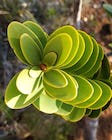
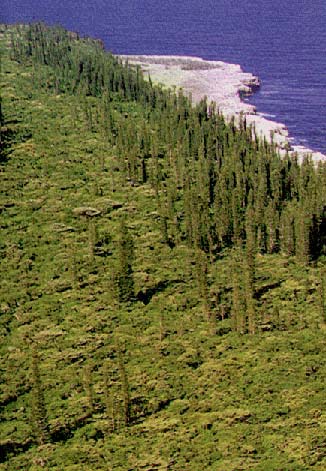
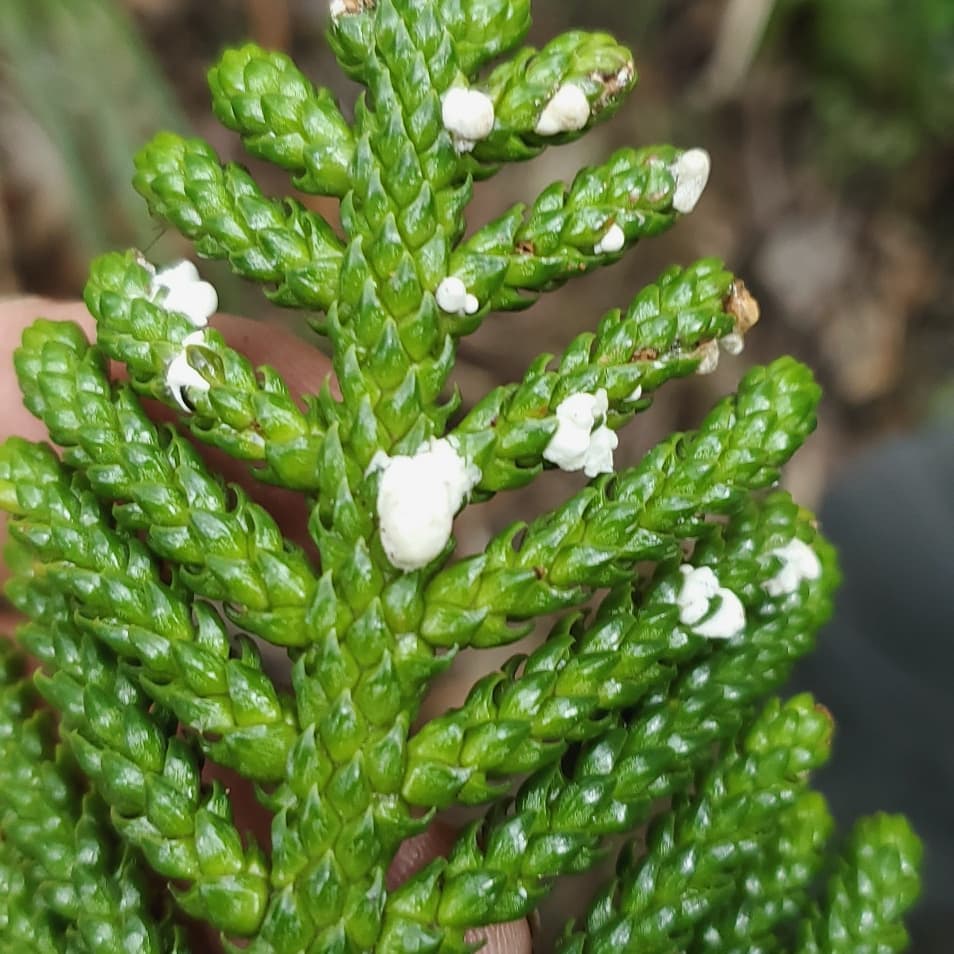


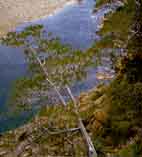
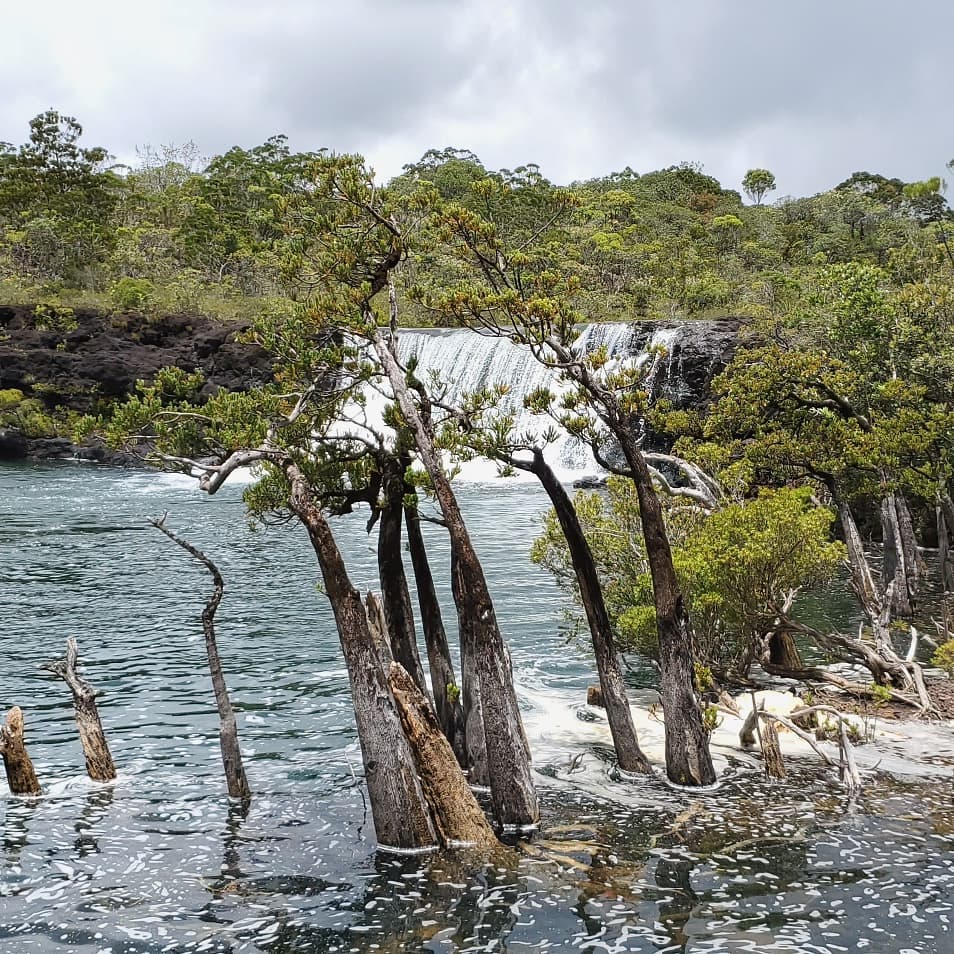











Conifers of New Caledonia
New Caledonia (French, Nouvelle-Calédonie) is an archipelago nation of 18,575 square kilometers in the equatorial southwest Pacific Ocean, about a thousand kilometers east-northeast of Australia. The main island is the Grande Terre (16,372 km2), but there are many outlying islands; conifers are found on the Île des Pins (named for its extensive stands of Araucaria columnaris) and in the îles Loyauté. Most conifers in the islands occur in mountainous terrain; the Grand Terre has fairly extensive areas at elevations of more than 1000 m, culminating in Mont Panié at 1628 m; the islands are much lower.
The geology is extraordinary, featuring one of the world's most extensive outcrop areas for ultramafic rock, which has a mineralogical composition resembling the Earth's upper mantle. Soils derived from such rocks are thin, extremely nutrient-poor, and rich in metals that most plants will not tolerate, such as nickel and chrome. New Caledonia is one of the few places where plants not only grow on ultramafic rock, but many species only grow on such rock. Ultramafic rocks are also New Caledonia's major environmental problem; the area is one of the world's primary producers of nickel and chrome, and open-pit mines to exploit these resources constitute the nation's primary industry, and represent the primary threat to native plants in terms of loss and degradation of habitat. The threat is severe, not only because much of the land base may ultimately be exploited for minerals production, but also because the great majority of New Caledonia's flora is found nowhere else on Earth. The area's vegetation includes 5 families, 107 genera and 3,380 species (among them, 3 conifer genera and all 45 conifer species) that are endemic. This very high rate of endemism is a consequence not only of the unusual geology, but also the island's extreme isolation from other land masses and the long duration of that isolation; the island contains rocks that formerly were part of Gondwana, but the land mass emerged from the sea about 30 million years ago as a result of plate tectonic processes. Consequently all of the terrestrial plants have either traveled to the island from elsewhere, or have evolved on the island.
The only other places on earth that even approach New Caledonia's level of conifer diversity and endemism are New Zealand, California and Sichuan, all of which are very much larger but have fewer endemic species. New Caledonia is home to nearly half the world's species of Araucariaceae (19 out of 45 species), and also supports 19 species of Podocarpaceae, 6 species of Cupressaceae, and one of Taxaceae. As you might expect, some of these are among the rarest conifers on Earth. Four conifer species are classified as Critically Endangered, 13 as Endangered, 6 as Vulnerable, 7 as Near Threatened, and only 11 as Least Concern. Wetland habitats contain 2 threatened species, both inadequately protected in a single reserve. High altitude forest and maquis have 7 threatened species, only partially within protected areas. Thirteen threatened species are restricted to low and mid-elevation forests, and another 3 species that can also occur on non-ultramafic substrates have isolated, unprotected populations in small forest remnants. Perhaps the most extraordinary aspect of the conifer flora is that 27 species have only been recorded as growing on ultramafic substrates, with another 12 species found on varied substrates including ultramafics. Ultramafic substrates are uncommon on a global scale, but they are widespread in some areas, such as in parts of California, Cuba and Turkey; nowhere else, however, do they have a conspicuous association with gymnosperms.
The climate is wet tropical, with a hot and humid season from November to March with mean daily temperatures between 27°C and 30°C, and a cooler, dry season from June to August with temperatures between 20°C and 23°C; in the mountains these differences diminish and, while the climate is slightly cooler, precipitation continues throughout the year, amounting to about 1,000 mm per year on the west coast, 2,000 mm on the east coast, and much more in the mountains. Besides climate, soils, and land use (mining), vegetation types are also constrained by wildfire, which is mostly anthropogenic, and has dramatically reduced and fragmented the original vegetation cover.
The most distinctive New Caledonian habitat is maquis miniers, a shrub-dominated habitat underlain by ultramafic substrates. The dominant vegetation is evergreen sclerophyll, sometimes with a dense sedge (Carex spp.) substratum, and often with an overstory of Agathis ovata or Araucaria spp. The forest trees are highly shade-intolerant, so the forest is at best very open, and usually has the character of a woodland. In sharp contrast to European maquis habitats, it can be quite moist, with most conifer-rich maquis occurring at elevations over 600 m and receiving rainfall of more than 2000 mm per year.
Rainforest is also a common habitat type, supporting more New Caledonian conifers than any other habitat. It primarily occurs on the flanks of the mountains that stretch down the long northwest-southeast spine of New Caledonia and milk rain from the trade winds and tropical cyclones, and rainfall generally increases with elevation. The rainforest starts at about 300 m elevation and the low altitude to montane forest, from 300-1000 m elevation, receives about 1500-3500 mm of rain annually. Although this forest contains no exceptionally large trees, it does sustain fairly high arboreal species diversity, including most of the conifers that are logged for timber. The 11 conifer species found in this forest are sizable trees, growing in the canopy or emergent above it. Although most conifers occur dispersed amongst the hardwood, various species of the Araucariaceae can form highly conspicuous pure (or nearly so) stands. Above about 1000 m elevation the forest changes to a cloud forest receiving more than 3500 mm precipitation annually. Trees are much shorter, about 3-8 m tall, and angiosperm dominance gives way to a great profusion of mosses, lichens, ferns, and of course conifers, which occur in all strata from the forest floor to canopy emergents. Six species of conifer grow only or largely in this highland forest.
Other habitats include riparian areas, wetlands, low forest (elevation less than 300 m), and coastal habitats. Some conifers occupy these habitats but they are largely dominated by angiosperms.
Smith (2004) provides the following comments on species occurrence within the principal habitat types: "Where [tropical and subtropical rainforest with coniferous elements] occurs there is often a gradient from a lowland rainforest to an evergreen cloud forest. Overall fourteen species of Araucariaceae, eleven species of Podocarpeaceae, two Cupressaceae and a single species of Taxaceae occupy niches in these forests. The Araucarians (Araucaria and Agathis species) plus Retrophyllum comptonii and Dacrydium araucarioides form both the canopy and emergent layers (however, these latter two form an emergent layer only on 'cuirasse' boulder fields that are largely unvegetated), and Austrotaxus spicatus, Libocedrus austrocaledonica and the majority of the Podocarpaceae are found in the understorey. Angiosperms such as Metrosideros (Mytraceae) and Quintinia (Saxifragaceae), and primitive groups such as Winteraceae are also found in the understorey and canopy. Most species have strong Gondwanan associations. In some areas unusual, almost pure tree layer stands occur, such as Agathis montana on several mountain tops and Callitris pancheri in some wetlands in the south of the main island, and Araucaria columnaris in a pure narrow band on calcareous rocks on the seashore on the main island, the Isle of Pines and the Loyalty Islands."
This maps shows families and genera of New Caledonia conifers. Araucariaceae icons contain the letter "A", Cupressaceae the letter "C", Podocarpaceae the letter "P", and Taxaceae the letter "T", with genera assigned to colors within each group. Click on an icon for information on species and collection date. Distribution data from GBIF (2020.03.30), edited to remove duplicates. Approximately 2,000 records are shown here.
Species descriptions, photographs and distribution maps are available at the Association Endemia site. A fine discussion of the island's biogeography and flora, with many maps and photographs, is available at the Diversity, Endemism and Extinction in the Flora of New Caledonia site.
Jaffré, T., P. Bouchet, and J.-M. Veillon. 1998. Threatened plants of New Caledonia: Is the system of protected areas adequate? Biodiversity and Conservation 7(1): 36.
Jaffré, T., J. Munzinger, and P. P. Lowry. 2010. Threats to the conifer species found on New Caledonia’s ultramafic massifs and proposals for urgently needed measures to improve their protection. Biodiversity and Conservation 19(5):1485-1502.
Papineau, C. 2002. State of Forest and Tree Genetic Resources in New Caledonia. http://www.fao.org/DOCREP/005/AC485E/AC485E00.HTM (accessed 2006.11.19).
Most data for this table are from Jaffré 1995, which I strongly recommend you read if you have interest in the conifers of New Caledonia.
| SPECIES |
HABITAT |
SUBSTRATE (1) |
| Araucariaceae | ||
|---|---|---|
| Agathis corbassonii | Rainforest, 300-700 m | S |
| Agathis lanceolata | Rainforest, 200-1000 m | U or S |
| Agathis montana | Rainforest, 1000-1600 m | S |
| Agathis moorei | Rainforest, 250-1000 m | U or S |
| Agathis ovata | Maquis & Rainforest, 150-1150 m | U or S |
| Araucaria bernieri | Rainforest, 100-700 m, very tolerant | U or S |
| Araucaria biramulata | Rainforest, 250-1150 m | U or S |
| Araucaria columnaris | Rainforest, 0-100 m, coastal | U or C |
| Araucaria goroensis | Maquis & Rainforest, 150-550 m | U or S |
| Araucaria humboldtensis | Maquis & Rainforest, 800-1550 m | U or S |
| Araucaria laubenfelsii | Maquis & Rainforest, 400-1300 m | U or S |
| Araucaria luxurians | Maquis & Rainforest, 0-200 m, very tolerant | U or S |
| Araucaria montana | Maquis & Rainforest, 300-1350 m | U or S |
| Araucaria muelleri | Maquis & Rainforest, 150-1000 m | U or S |
| Araucaria nemorosa | Rainforest, 0-50 m, <2000 mm annual ppt. | U only |
| Araucaria rulei | Maquis & Rainforest, 150-1200 m | U or S |
| Araucaria schmidii | Rainforest, 1500-1600 | S |
| Araucaria scopulorum | Maquis & Rainforest, 0-200 m, <2000 mm annual ppt. | U or S |
| Araucaria subulata | Rainforest, 300-1000 m | U or S |
| Cupressaceae | ||
| Callitris neocaledonica | Maquis & Rainforest, 950-1350 m | U or S |
| Callitris pancheri | Maquis & Rainforest, 850-950 m | U or S |
| Callitris sulcata | Maquis & Rainforest, 50-200 m | U or S |
| Libocedrus austrocaledonica | Rainforest, 700-1300 m | U or S |
| Libocedrus chevalieri | Maquis, 1450-1600 m | U only |
| Libocedrus yateensis | Rainforest, 150-250 m | U or S |
| Podocarpaceae | ||
| Acmopyle pancheri | Rainforest, 100-1300 m | U or S |
| Dacrycarpus viellardii | Rainforest, 100-800 m | U or S |
| Dacrydium araucarioides | Maquis, 200-1000 m | U only |
| Dacrydium balansae | Maquis & Rainforest, 150-900 m, very tolerant | U |
| Dacrydium guillauminii | Riparian, on the Rivière des Lacs and the edge of the Lac en Huit. | U or S |
| Dacrydium lycopodioides | Rainforest, 900-1400 m | U or S |
| Dacrydium x suprinii | Riparian, on the Rivière des Lacs and the edge of the Lac en Huit. | U or S |
| Falcatifolium taxoides | Rainforest, 100-1400 m | U or S |
| Parasitaxus usta | Rainforest, 150-1100 m | U or S |
| Pectinopitys ferruginoides | Rainforest, 150-1400 m | U or S |
| Podocarpus decumbens | Maquis, 800-1000 m | U only |
| Podocarpus gnidioides | Maquis, 600-1600 m, on rocky or lateritic crests | U only |
| Podocarpus longifoliolatus | Rainforest, 1100-1200 m | U or S |
| Podocarpus lucienii | Rainforest, 200-1100 m | U or S |
| Podocarpus novae-caledoniae | Maquis, 50-750 m | U only |
| Podocarpus polyspermus | Rainforest, 650-950 m | U or S |
| Podocarpus sylvestris | Rainforest, 150-1200 m | U or S |
| Retrophyllum comptonii | Rainforest, 750-1450 m | U or S |
| Retrophyllum minus | Riparian | U or S |
| Taxaceae | ||
| Austrotaxus spicata | Rainforest, 500-1350 m | S |
(1) Substrate types: U = Ultramafic; S = Silica; C = Carbonate. |
||
Jaffré, T. 1995. Distribution and ecology of the conifers of New Caledonia. Pages 171-196 in Neal J. Enright and Robert S. Hill (eds.), Ecology of the Southern Conifers. Washington, DC: Smithsonian Institution Press.
Last Modified 2023-12-16